Designing and Producing high-engagement Hybrid Conferences
How to run large (100+) participatory events which are hybrid
During the pandemic events (conferences, summits, symposia, meetups, gatherings) shifted from being in-situ (in the same physical space) to online. This was not only a shift of medium but also a shift of various other factors as well, such as who could participate, frequency, cost, levels of collaboration and so on. While there are many downsides to online conferences, such as lack of physical proximity and context, attention span, lack of kinesthetics, screen fatigue and so on, there were many unexpected upsides too, such as people who previously could not participate in the same event (due to geographic location, cost, or availability) suddenly found they could, or because of lower costs more people could be involved. Online collaboration also became a lot easier due to the many simultaneous collaboration tools (Googledocs, Miro, Mural, Trello, QiqoChat, etc.) available.
It is no wonder, then, that after Covid people don’t simply want to return to the previous way of running events, but rather would like to incorporate all the new benefits they experienced during the pandemic, such as reduced travel time, wider spread of perspectives, live collaboration tools etc. Consequently, the demand for hybrid conferences has grown enormously. Which is a lot more easily said than done.
Running broadcast (one to many) types of hybrid conferences, which are driven by speeches/presentations, or panel discussions with limited participant engagement (such as Q&A or brief expression of opinion through a moderator) is less difficult to do, indeed broadcasting companies have been doing that for the last 50 years. Running larger high engagement participatory (many to many) conferences, on the other hand, i.e. events which are centred around the participants self-organising in smaller groups with cross-functional serendipitous pollination of ideas, without central figures of attention (presenters, moderators, celebrities etc), are substantially more difficult and costly to do it in hybrid form. This article concentrates on this latter type of participative many-to-many event, like Open Space, of over 100 participants.
Online Open Space Unconferences (Open Space Technology) have opened up a whole new range of possibilities, especially in the realm of international collaboration or cross-sharing, as well as around issues which are deemed complex. With online voice recognition, transcription and automatic translation, global gatherings are now possible and relatively cheap to run online. This means people can rally behind certain issues both locally, in locally organised meetups or conferences, as well as cross-share local hub experiences and know-how in mega global Open Space conferences online. Open Space is the penultimate form of participatory, large-scale event, but there are other large group interventions (World Cafe, Appreciative Enquiry etc) which have a similarly high degree of participation and intermingling - penultimate because Open Space is the only form where the session agenda is 100% determined by the participants themselves there and then in the moment in a 'marketplace' around an overall theme. Precisely because of this lack of a pre-planned (pre-conceived) agenda, Open Space is ideal for complex issues, in contrast to more traditional conferences centred around expertise.
As we become more aware of complexity and the need for holistic approaches to tackle the various issues and crises our global societies are facing, so the demand for online Open Space will increase, where cross-disciplinary multi-perspectivity is paramount. We know how to do this in situ with hundreds of participants in the same location; and we know now know how to do this globally online too. The question is, how do we do this 'hybridly', that is involving both an online component as well as an in-situ part (or possibly even several in-situ components simultaneously in dispersed located hubs)? That is the subject of this article.
The key word is participatory or high engagement. There have always been plenty of presenter/broadcast-based events, which are not participant-led, but rather celebrity-driven, with only limited, controlled engagement with the audience. These were never truly participatory in any shape or form. And yet now the demand for something more sophisticated (with real engagement, where participants can have a deeper say and can be heard) is growing across all sectors.

Participatory events normally involve a high use of breakouts – in-situ these are physical spaces or separate rooms for small group conversations, and online the breakouts or group facilities of the used video platform are applied for small group video conversations (e.g. Zoom breakouts). Whether in-situ or online, there is a high degree of self-organisation involved, which itself requires a lot of shifting around with people moving from group to group or plenary freely themselves. All fine when people are all in the same physical venue, or when they are all on the same Zoom call moving from breakout to breakout – but now try to intermix those two completely different worlds, and it becomes quite a different matter.
Large-scale participatory conferences which are hybrid are growing in demand. Yet most people are unaware of the complexities of trying to mix and intertwine fundamentally different worlds. Consequently simplistic so-called ‘hybrid solutions’ abound. And as a result, many hybrid events are pretty miserable, at least for most participants themselves. Does that mean we shouldn’t do them?
Well yes and no.
- Yes: We can run hybrid conferences, but a lot more attention and resources need to be given to make them engaging and meaningful – that’s the subject of this article
- No: We shouldn’t run hybrid events on the cuff, flippantly, they are very difficult and costly to orchestrate and run well, i.e. where all participants have an enriching, even life-changing experience.
Most conferences, even before hybrid, and even before online, were pretty morbid and miserable from an engagement point of view. Yes, some are very flashy, some are entertaining, and some are indeed very interesting, but very few are transformational, with genuine cross-functional serendipitous exchange, which really comes from the dialogue and interchange between participants themselves. So, if conferences, whether in-situ or online, were poor from participants’ perspective to begin with, then there is no way hybrid is going to make them any better – on the contrary, it can only make matters worse.
Therefore, as a principle, avoid hybrid conferences if at all possible unless you know what you are doing. One precondition is that you know how to run participatory events well in situ, and that you can also do so online too, because if you can’t get either of those right separately, then any hybrid attempt will be futile – you are certainly not going to get better results in hybrid mode. Consider all other options first. But if there is no alternative, then make sure you do it properly.
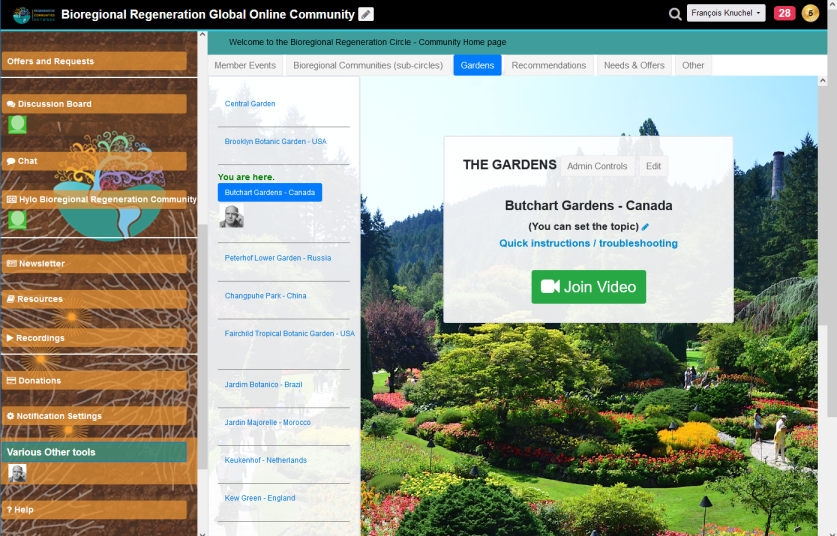
So what are hybrid events which are also truly participatory?
Simply put hybrid conferences normally refer to events which combine in-situ participation with online engagement. For a participatory event, this means the in-situ people are able to mix and interact with the people online synchronously (at the same time) ideally feeling just as they would intermixing in a conference coffee break. The two elements (worlds) are:
- In-situ participants in the same physical space (co-located & synchronous) – the “Roomies”
- Online participants interacting via video conference (a-located & synchronous) – the “Zoomies” *
* Note Zoom is used here to denote any kind of video conferencing platform (Googlemeet, MS Teams, Jitsi, Hoot, Whereby, Butter, GoToMeeting etc.). The source of the terms 'Roomies' & 'Zoomies' is unknown to us (not our creation).
Strictly speaking, there are more forms of engagement than the two mentioned:
- Live-streaming with chat
- Post-conference recordings
- Asynchronous conversations on dedicated discussion forums (social media, email lists, groups etc).
The latter are ‘asynchronous’ in that people react and respond in their own time, sometimes days later. In other words, there is no in-the-moment interaction. Consequently, these other forms are easier to arrange as ‘add-on’ features. For the purposes of this article, we shall concentrate on just the first two, the live-in-the-moment in-situ or online participation.
The biggest difficulty of hybrid events is in the live interaction between the in-situ people and the online people. The key difficulty is that Roomies can operate well together in situ in their own world, and Zoomies can also operate well together on Zoom, but they are operating in fundamentally different worlds. So when you try to bring the two worlds together there is a massive clash of milieu.
Simple examples of how the worlds are different include:
- Background noise in the room: everyone can see what is happening in the room; but with limited vision, Zoomies have no idea what is going on (or that anything is going on in the first place).
- On the other hand, Zoomies are involved in a Chat conversation, often a sub-conversation is taking place in Chat, which the Roomies are completely not privy to.
- Zoomies can take online notes collaboratively, with several people contributing simultaneously, in google docs for instance; this is more difficult in-situ, so people normally have to rely on a ‘scribe’ willing to take hand-written notes for the group (which are later typed up).
- Someone in situ snaps a finger to attract attention, and everyone turns around; while online people may hear something, they have no idea what is occurring.
- Conversely, online someone cracks a joke in chat and everyone laughs, but the in-situ people don’t see that and have no idea what people are laughing at.
- Due to proximity bias, people pay more attention to those close to them in person, and can easily ignore ‘distant’ online participants.
- Breaks, refreshments and meals tend to be more communal for Roomies, while Zoomies leave the screen and attend to other matters (impossible to have the same meal together)
- Roomies are more willing to attend full-day conferences, while Zoomies tire easily after half a day. On the other hand, they can come and go discreetly.
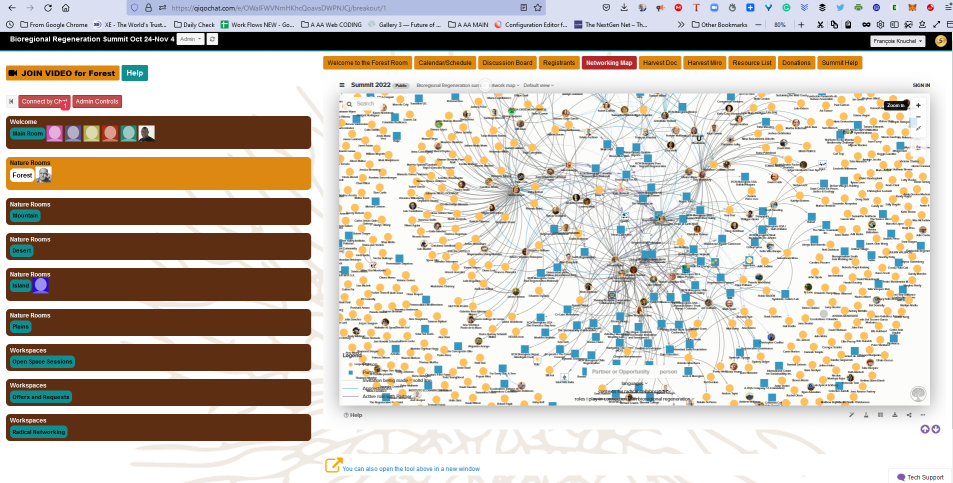 |
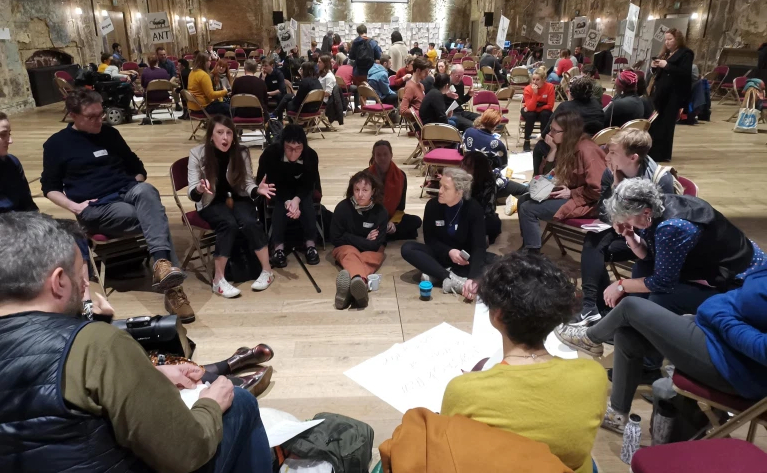 |
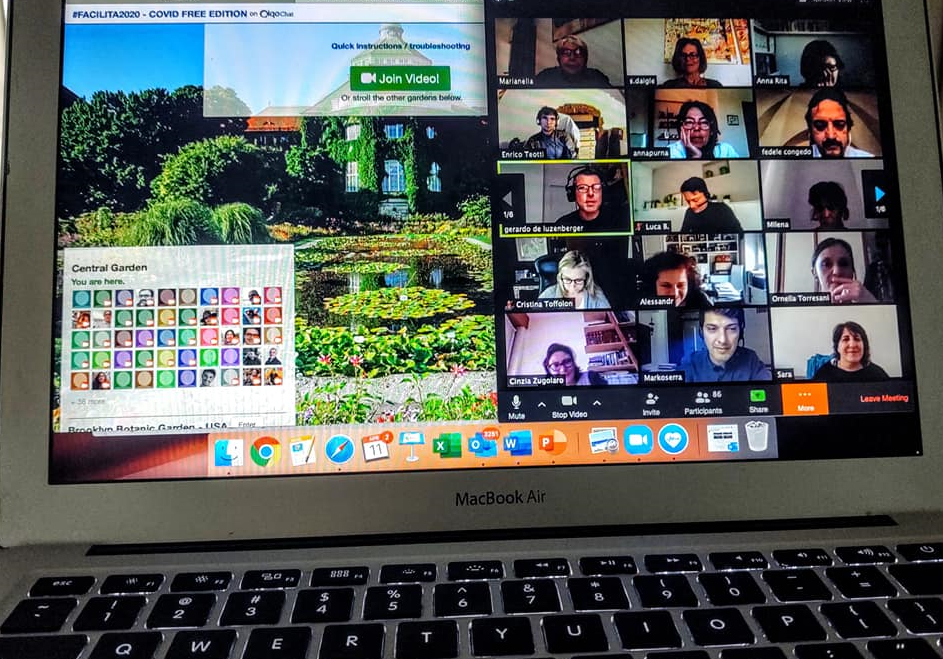 |
The in-situ people and the online people inhibit two completely different 'worlds' or environments, with different rules, visibilities, ambience, sense of connection and access. Each can function perfectly in their own world, but coming together that’s a completely different story.
So how do we bring the 2 worlds together? They are like different cultures operating by different rules in different sensory environments. One way of thinking about the difficulty is how would you get couples to dance together where one partner is in a physical room and the other online on Zoom only. And do that with multiple couples? And then have partners swap partners? Spontaneously? And still have deeper meaningful exchanges? This is the challenge of hybrid, how do you bring those two different worlds to communicate meaningfully together?
It is not too difficult to orchestrate ‘shorter’ broadcast-type of interactions in-situ and online at the same time, because those interactions are largely one or two-directional (speaker to audience, participant to moderator, moderator to presenter etc.) – it is 'easy' to manage the technology for one or two directions, whether in-situ or online. Participatory events, however, are largely multi-directional, so not one-to-many or one-of-many-to-one, but rather many-to-many, without being able to predict which many will converse with which other many where, when and how. Additionally, one proportion of the many is in one type of space (in situ, in-person), while the other proportion is in a completely different space (online), making the web of interactions unpredictable and complex.
So, what can be done to bring the two worlds together, to get the Zoomies and Roomies mixing and interacting with each other? Well, the simplest and cheapest, is not to even try to bring the two together: Just keep the Roomies and Zoomies in their own environments. This would then be like running two conferences in parallel, with no or very little cross-over. This is by far the cheapest and easiest to do, but of course, it is not hybrid. Yet unless there is a clear and specific reason why the two worlds should be interacting with one another, this is our recommended approach, while focussing on harvesting (note-taking or record-keeping), so that the people from either world can read or hear the respective reports or recordings of the other world later on.
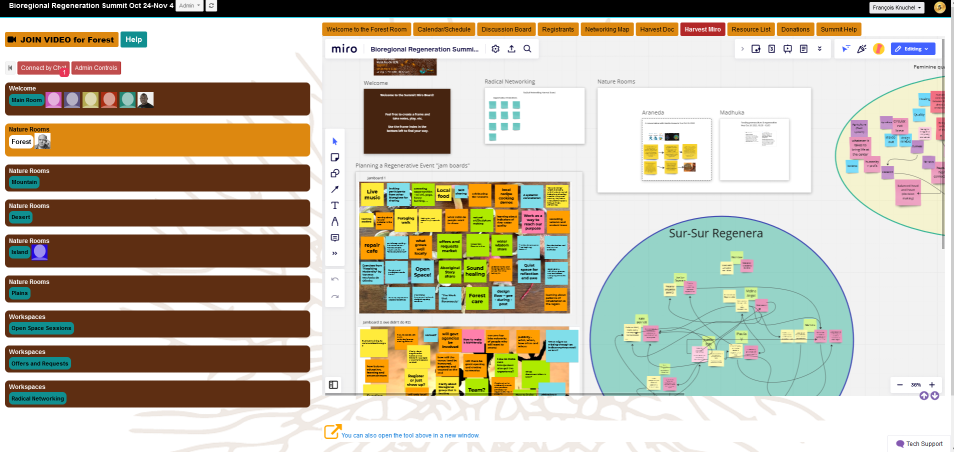
Full Hybrid
If, however, there is a clear enough purpose or cause backed by a substantial budget for bringing the Zoomies and Roomies into the same 'space', then this requires us to create as many breakout rooms as the size of the audience (rule of thumb 10 people per breakout room, so 300 participants would require 30 breakouts, plus a few extra). These breakouts would have to exist physically at the event venue as well as in parallel in Zoom. Each physical breakout room would need to be linked to a matching Zoom breakout, with both Zoomies and Roomies still able to move from breakout to breakout, or to other ‘networking’ spaces, freely themselves. Consequently, each in-situ breakout room would need to be equipped with fully hybrid capacity – with cameras (ideally 360 Owl cameras), screen, projector, speakers etc, while also considering the noise interference from neighbouring rooms.
Overall we need to consider two aspects: the Technical infrastructure and Human interaction.
The Technical requirements: These include (but are not exhaustive):
- Cameras on tripods to cover all angles of the active venue to project main space participants into Zoom
- Lighting to cover all parts of the active venue, including break-out rooms
- Projector & Screen(s) to project Zoomies in Zoom into the live main room space
- Speaker(s) for the main room and for each breakout room
- Roaming mics and presenter mics for the main room
- Sound and video mixing equipment to manage various activities
- 3600 Owl cameras with mics, one for each in-situ breakout room

- Screen and speakers for each of the breakout rooms
- Back up equipment to manage glitches
- Miscellaneous video/audio cables, ethernet ports, power extensions
- Zoom or video software integrated with the mixing equipment
- An online platform enabling online participants to move around freely
- Miscellaneous online shared collaboration tools (Google docs, Sheets, Boards etc.) ideally to work offline too
- Enough bandwidth in the venue to cover all the requirements from a technology perspective, as well as additional bandwidth to cover facilitation and participant needs, personal laptops, smartphones etc. (Warning: technology crew will usually prioritise their own needs only)
- A technical crew to manage all the equipment and movements
- A technical production manager to oversee all aspects
- A large number of helpers who make sure all the technical requirements for each of the breakout rooms are met
- Online technical support person from the facilitation team who can both support Zoom participants in difficulty as well as coordinate activities with the above production manager
- Team of support facilitators to help with the participants’ needs, and support the main facilitator
- Back up plan in case of a major technical failure (e.g. power cut, drop in bandwidth etc.)
- Clear instructions, both in articulation and easy accessibility, for participants
* Note all technologies mentioned are based on available technology of 2022. It does not include future AI and Virtual Reality technology, which could change the game completely once available at affordable prices; nor does it include corporate multi-million dollar hi-tech 3D video conferencing equipment, as this is normally not available for one-off conferences.

The technical requirements will vary depending on the size of the audience. It should be noted that most of the above technical requirements are NOT required in in-situ participatory conferences, and are also NOT required online either (except for platform software). In other words, these are clearly additional requirements that arise from making a conference hybrid. It should also be noted that because hardly any technical equipment or technology is required, either in-situ or online for participatory events, most facilitators will not have been trained to work with technology and might struggle in that sort of technology-intensive environment.
Human interaction: The following are some of the considerations the facilitation team need to pay attention to:
- Consider how the 2 worlds could interact with each other at each stage
- Be very clear about how engagement is achieved stage by stage
- Both zoomies and roomies need to be seen and heard all the time
- Design so that everyone can move around freely and actively participate
- The step-by-step design flow of the conference needs to be briefed properly to all support staff
- This includes a clear script of proceedings that all can refer to
- Careful planning of timings, including breaks (different needs in-situ and online)
- A more detailed description of the online preparation work can be found in this checklist.
- The success of participatory events, once the technology has been covered, depends largely on the skill of the facilitator(s) (not moderators!). This is beyond the scope of this article.
- Careful handling of power imbalances (facilitators needing to be aware of their own tendencies)
- Periodic checking-in and sharing of how people feel in the different cohorts
- Setting out rules of engagement (e.g. what I need from you)
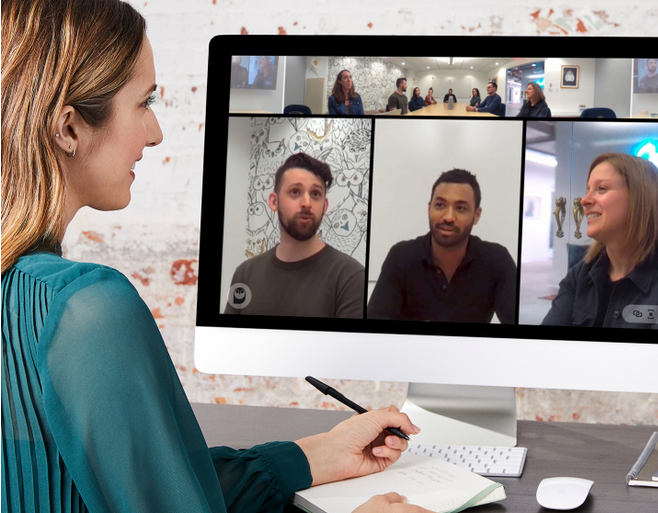
The human side of the equation is more difficult as it requires facilitators to work with unpredictable people. Meeting all the technical requirements first, however, will go a long way in ensuring that the technology does not add to the facilitators’ burden on the day, especially when they are not technically savvy (until now they have not needed to be).
It is also worth considering what kind of roles might be needed for an interactive hybrid event (the number of staff varies depending on the type of event and participants).
Roles to consider include:
- Event Designer (both spatial in situ and online platform holding the pieces together (e.g. QiqoChat)
- Lead Facilitator, who normally runs the show online (backbone)
- Lead Support Facilitator, who facilitators the in-situ proceedings, aligned with Lead Facilitator
- Support facilitator(s), including time-keeper
- Bridge builder(s) connecting the various cohorts
- Visual designer & curator
- Audio-visual specialist
- Online Platform Technical Support (helping participants with online technology)
- Lead Technician (managing in-situ technology)
- Technical supporters (camera, mics, lighting)
- Producer keeping all the parts together (liaising facilitation with technical)
- Possibly Graphic Facilitators
- Translators, interpreters, Access specialist(s)
- Other specialists and additional helpers may be required depending on the needs of the event
It should be evident from the above that hybrid is costly. This is because of the additional equipment that needs to be hired, the technicians to operate it, and the extra facilitators and helpers required to make it work. It is also more difficult and quite taxing on producers and facilitators. A fully hybrid participatory conference of over 100 people could easily add £5,000 – £20,000 per day* on top of just the cost of running an in-situ or just an online event.
* The situation is different, however, for summits within organisations that already have top-end multiple virtual video conferencing equipment installed and used on a frequent basis.
Ultimately the question needs to be answered: what strategies are in place to support and ensure inclusion? And do these justify the costs?

Are there Simpler and Cheaper Alternatives?
Yes, there are, it all depends on what one is willing to compromise. Indeed there are quite a number of alternatives, each relinquishing some different aspect of hybridity. I call these Semi-hybrid. Some people might take the opposite view and say that if an event has got a small hybrid component, then the whole event is hybrid, a valid perspective, possibly arguing over semantics, but for this article, I shall regard anything that is not fully hybrid as semi-hybrid, simply because some hybrid aspect is missing. Below are listed a few ideas, though this is by no means comprehensive.
Semi-Hybrid Events
If the budget isn’t there or the purpose does not justify the full cost, consider running two separate parallel events instead, one online, the other offline. Alternatively, there may be a few in-between semi-hybrid options you may also want to consider:
- One World Plenaries, Two World Breakouts:
Conferences which have a combination of broadcast and participation, e.g. one-to-many presentations/provocations interspersed with many-to-many breakout conversations, could be run as two parallel events at the same time with some joint points. So for instance, the plenary presentations could be run jointly from the main room, and the breakout conversations are run separately, i.e. the Roomies amongst themselves in in-situ breakouts and the Zoomies in Zoom breakouts. In this scenario little or no content of the various conversations flows into each other's worlds, but by careful recording, harvesting and note-taking some of that can be alleviated. This approach does not eliminate the need for equipment and technicians in the main room, but it does remove the need to have expensive equipment and helpers in each of the breakout rooms. While substantially cheaper (£3,000 – £8,000 per day in addition to normal cost), it would not quite achieve the same level of engagement, and would also prevent cross-fertilisation of ideas between the Roomies and the Zoomies.
- Barcamp Style:
BarCamp-style events were popular among the IT crowd in the early 2010s. These were unconferences where all the Roomies brought their own laptops. The event was then basically online (Zoom, collaboration documents), but the Roomies were in the same room or breakout space in a circle looking at both the other Roomies as well as the Zoomies on their laptops. This worked to a certain degree, as it eliminated to need for expensive equipment in the room, rather relying on the ‘expensive’ laptops that each Roomie brought with them into the room. There are potential issues with feedback noise, and the bandwidth requirements are substantial due to all the laptops operating on WIFI in the same space at the same time. Because only the Roomies could move around themselves, the Zoomies were often at a disadvantage even though the conference was designed around the online video conference. This style of event would be limited to participants who were willing to bring and use their laptops to the venue, a requirement that might not go down well with some people. Nowadays smartphones instead of laptops could make it easier, although it is very difficult to work and collaborate on very small screens.
- Laptop on Chairs:
Another variation is a combination of the first two. You have a Plenary main room which is completely hybrid, and you have breakouts in person as well as on Zoom, but instead of the expensive equipment for each breakout you ask some volunteer participants to use their laptops or smartphones to connect to the same Zoom breakout and capture whoever is talking, and another volunteer participant to place his laptop as a screen to show the Zoomies online. This can work in an informal self-organised setting where all the participants know each other. While it can save a lot of money, this set-up is also rife with problems and potential pitfalls: It relies on volunteers willing to use their phones to do this; it restricts the movement of the volunteers as they are now performing a specific duty rather than focussing on the dialogue; it can disrupt the flow of the conversation every time something is not quite right (e.g. camera pointing in the wrong direction, utterances inaudible, turn-taking goes out of order etc.), and most importantly, the biggest danger of all is that more than likely Zoomies will begin to feel left out, get frustrated and drop out, with a huge drop in engagement – this occurs again and again, despite good intentions. So, though it is a cheaper option, it is fraught with potential dangers.
- Ulab MOOCs:
Otto Scharmer’s Presencing MOOC model presents another interesting approach. Several short global plenary sessions online with several thousands of participants are spread over several weeks. There follow a mixture of presentations, video interviews, mindfulness and several small group conversations in online breakouts. These sessions are interspersed between local hubs forming and getting together in person to review the tasks and activities and form deeper relationships and sometimes action plans – these hubs are completely self-organised. In addition, and separately through the Presencing platform, little Case Clinics of about 5 people each form and meet regularly and follow a specific process. This uses a mixture of online and in-situ features, and while strictly not a conference they do generate a good deal of participant engagement. Note the self-organising aspect of this format relies on a sophisticated MIT proprietary matching software which is not available, but other self-organising approaches could be developed.

- Stretch over time, combining synchronous and asynchronous:
One might ask the question, why run a summit or event as a half-, one, two or 3-day event, with everything compacted in that time frame? In-situ that makes sense, especially if travelling is involved. Why not design an event that runs spread out over several weeks, with different sessions and workshops interspersed over the period instead? This allows for more flexibility and people can self-organise around specific issues, or form local hubs and meetups in person. This works really well, as people do not have to block out whole days. On the other hand, these stretched-out events tend not to be transformational, and with energy dissipated over time, they do not have any magic. That’s because magic does not happen in asynchronicity, magic is very much in the moment. Consequently, I would suggest designing-in one or two shorter, say half-day, intensive peak events where everyone comes together at the same time as part of the longer event.
- Ongoing Online Community Spaces:
Regardless of what format one uses many participatory events often have little follow-through. While individuals and groups of people may very well follow on with specific activities, there is often a sense of a big climax followed by nothing, with the momentum of the conference dissipating into emptiness until the next conference. We are asking ourselves how can we keep the momentum of an event alive and thriving, so as to have more impact in the long run. We are experimenting with Online Communities or Circles to address this vacuum. As it turns out Online Communities or Circles are also the best place to involve those who only followed a live stream with limited engagement, as well as those who just listened to the recordings. Asynchronous conversations, self-organised meetups or workshops, or self-help groups are just some of the features online communities enable. This is discussed in more detail here.
- Smaller in-situ events consolidating into online conferences:
Why not break up larger conferences into a number of smaller local events, each with an in-situ event, followed by an online-only summit joining them all together? This is really a combination of separate online and in-situ gatherings, it is not hybrid at all, because the gatherings do not take place at the same time. It does mean, however, there is no need for most of the expensive hybrid-induced technology. A variation of this is running an annual Open Space event as two bi-annual events, one in person alternating with online every 6 months. Depending on the purpose of the gathering, this may work very well. Note, just because we can (run semi-hybrid events) doesn't mean we should - indeed why incur the extra cost of hybrid just for the sake of being hybrid? Let common sense prevail.
- Breakup into series of smaller events:
Rather than having a large-scale hybrid event, split it up into a series of smaller events of less than 100 people, say 50 people. These can be hybrid or separate. It is a lot easier running hybrid events in smaller settings - there are quite a few hybrid event manuals out there explaining how to do it, indeed most of what has been written about hybrid events tends to focus on smaller events. This is definitely an option to consider and makes things a lot easier and less expensive too. However, it is also worth noting what is lost in doing so: The conversations become more fragmented and people become frustrated. The magic of Open Space is lost. And having multiple events over time does not allow for cross-functional serendipity, which is vital when dealing with complex issues
- There are, no doubt, plenty of other semi-hybrid combinations possible that are just waiting to be imagined.
Most so-called “hybrid events” which are currently out there are actually only what I would call semi-hybrid, or for smaller audiences. Or they are not participatory. There is nothing wrong with that, as long as you are clear as to what you are trying to achieve. In my view, focussing on the participatory engagement nature of events is far more important, and if that means sacrificing full hybrid, so be it.
Whichever way you run your hybrid or semi-hybrid conference, however, ALWAYS design it around the remote participants first and foremost. The Zoomies are the ones that usually feel left out. Don't accidentally turn the in-situ part of a semi-hybrid event into an elite thing; as enticing as it can be for the in-situ in-the-moment connected people, with the people around them in the room; always think 'remote participants' first.

CONCLUSION
Despite the difficulties, I expect the demand for hybrid dialogue will increase. Maybe as demand grows so will conference venues emerge, which are already pre-designed and equipped specifically for hybrid events. I have no doubt that technology will evolve with new possibilities - I've already mentioned Virtual Reality, though this will not happen until everyone anywhere in the world can access the technology. Other attempts have shown possibilities, such as online gaming (e.g. Second Life but without anonymity). Or Spatialchat, GatherTown or similar, but which also cater for large interventions, record-keeping, agenda-setting and so on. And so far these are online-only solutions, so the whole question of the hybrid mixing of worlds remains unanswered at the moment.
Beware of what some people are calling hybrid, when they are not really fully hybrid, at least in the case of large-scale participatory conferences. So when a participant comes to me saying they went to such and such "hybrid" conference, but they were not technically able to connect with such and such, I have to tell them the conference was not really fully hybrid, yes sure it had some hybrid components, but it was not fully hybrid. Which in itself is fine, we have established that true full hybrid large-scale Open Space unconferences are a bit of an extravaganza, but let's be honest about it. Unfortunately, however, 'hybrid' is being banded around as a marketing buzzword, and this is misleading.
While participatory hybrid is not impossible, full hybrid is very difficult and expensive, and should only be attempted if there is a clear purpose backed by a big budget to cater for it. Ask why are you doing full hybrid, what is it you would like to see happen and does that justify the extra cost? And consider running semi-hybrid or straight alternatives instead. Think strategically over the long run, what could be run in different formats over time, to make it both more manageable as well as more cost-effective. Think strategically - what could be achieved through a balance of in-situ local hubs and online global events, possibly all joined together by creating Online Communities.
If you want genuine engagement, think again, think carefully. As a rule, it is best to follow the ‘one remote then all remote’ principle, i.e. if there is one participant who cannot attend in person then it is best to run the whole event online. Running online events does not exclude local hubs self-organising to meet in person in their own time after all, just as online people may continue conversations in an online format afterwards.
Most importantly, think it through carefully, and possibly get some advice to help you think it through.



